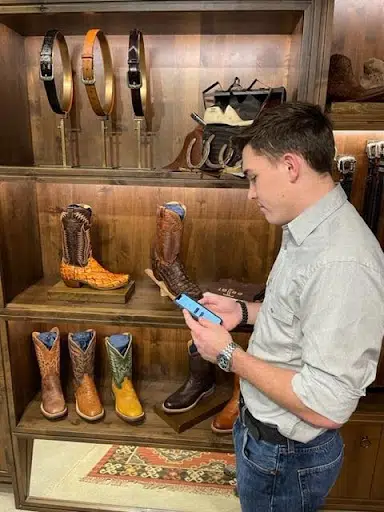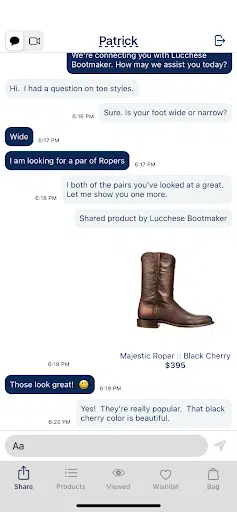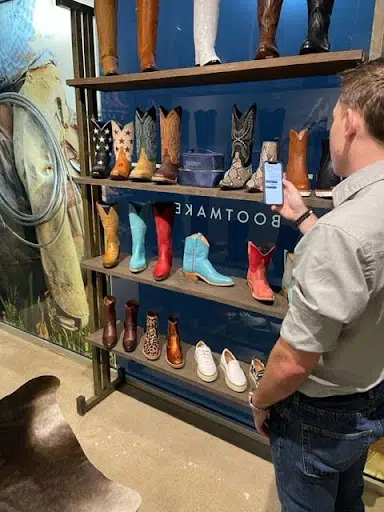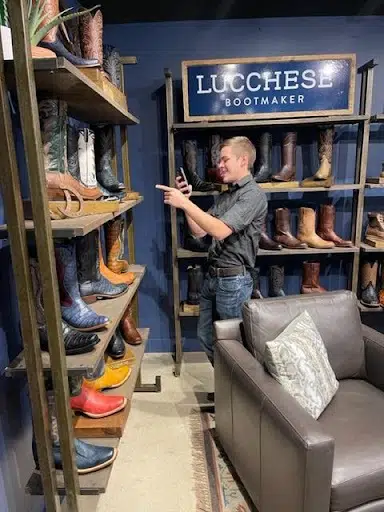How live clienteling is helping Lucchese sell more cowboy boots
Two-way video guided in-store customer engagement is the next best thing to the smell of fresh-cut boot leather.
“Lucchese got its start by making boots for the U.S. Cavalry based out of San Antonio,” said David Berger, Lucchese’s Head of Marketing. “We’re a premier Western lifestyle brand and we still follow the same handcrafted principles we had in 1883. Our customers love that we’ve upheld the quality and reputation that has existed for almost 140 years.”
Lucchese is the most successful maker of cowboy boots in America. The company was founded in San Antonio, Texas in 1883 by Italian immigrant Salvatore Lucchese and his brothers.

Although Lucchese’s customers are deeply loyal to the brand, the boots are a significant investment, ranging in price from $500 to $13,000. The nature of Luccese’s products combined with the higher cost of the boots meant that ecommerce sales were flat compared with in-store purchases.
“People’s preference to buy cowboy boots probably will always be in person,” said Berger. “It’s a very sensory-driven experience. Most people want to see, feel, and even smell the leather. We know that one of the best shopping experiences you can have — and one that we can control — is in our own stores.”
Lucchese needed a way to virtually emulate the in-person buying experience customers received when shopping in their physical stores. They were already using Immerss, a live commerce platform that enabled them to present their products in a one-to-many virtual environment (e.g., QVC style). With this approach, a host goes live and presents a list of products to an audience of multiple shoppers.
But Lucchese wanted something more personal, a way to virtually reproduce a similar shopping experience that customers got when buying in a brick and mortar showroom. That’s how two years ago, during a routine client meeting, Lucchese’s President and Immerss’s CEO came up with the concept of digital clienteling.
See a need, fill a need
In 2019, Doug Kindy, Lucchese’s President, met with Arthur Veytsman, Immerss’s Co-Founder and CEO. The meeting was about Lucchese’s existing live shopping solution (e.g., the one-to-many QVC approach). During their discussion, Kindy mentioned a common pain point that DTC brands have—namely, there’s no good way to service digital shoppers.
Kindy wanted to connect shoppers with live sales associates using a digital clienteling approach, enabling one-on-one conversations in real time as the customer was shopping.
“When I met with Doug Kindy, Lucchese only had one point of human contact for their online shoppers and that was their call center,” explained Veytsman. “A customer request was initiated through chat and routed to the call center. People who were shopping for a product on Lucchese’s website had no way of reaching a live salesperson. That was the point when Immerss’s digital clienteling arm was born.”
Lucchese was the first client to use Immerss’s MVP clienteling solution, signing on in the summer of 2019 and going live January 2020. After successfully piloting the solution with Lucchese, Immerss rolled it out nationally in March, then began scaling the platform for Shopify.
Said Veytsman, “Our role is to facilitate that connection between the shopper and a live salesperson and make sure it’s as close to a physical store visit as possible. The idea is that we’re connecting online shoppers with a retail associate who is on the floor either in the showroom or digital store.”

Rolling out a new solution
When they first began using the digital clienteling solution, Lucchese trained all their in-store sales associates how to use it which, as it turns out, didn’t take long.
“There wasn’t much training required to use the platform,” said Berger. “Even in its early days, it was pretty intuitive and straightforward.”
Berger noted that most of the time spent on training was focused on the product side. “Each boot has its own story,” said Berger. “From its construction to the materials where it’s sourced, there’s only so much you can communicate on a product page on your website. Immerss’s platform is enhancing our online shopping experience and helping to bridge that gap for customers who may be hesitant to purchase cowboy boots online.”
Sky high conversion rates and a growing digital showroom
Lucchese currently has 14 brick and mortar stores, all of which are in Texas, but their boots are in demand across the entire US.
With Immerrs, they can replicate the in-store environment for their digital customers, providing one-to-one assistance to shoppers in real-time. This is boosting online conversion rates and has motivated Lucchese to create a thriving digital showroom with five dedicated salespeople.

“Having the ability to speak with customers via Immerss is helping our digital business quite a bit,” said Berger. “We’re building a team around it and repurposing an existing showroom to use with the Immerss platform where we can show the products to our digital customers.”
Customers who use Immerss on Lucchese’s website convert at a 20-25X higher rate than those who don’t.
Said Berger, “The challenge is to figure out how can we drive more traffic through Immerss because the conversion rate is so much higher. It’s obviously a better experience for customers.”

Said Berger, “We’re seeing the retail landscape shifting to more of a direct-to-consumer model. I believe the reason for that is because customers want to interact directly with the brands they’re buying. That’s usually because the brands can offer a better experience themselves. The advice I would give to anyone considering a technology like Immerss is to be open to testing different business models as it relates to leveraging the technology. The tool itself is very powerful. Anything that can give you a closer, more personal, and more personalized interaction with your customer is a good thing.”
Contributing authors are invited to create content for MarTech and are chosen for their expertise and contribution to the search community. Our contributors work under the oversight of the editorial staff and contributions are checked for quality and relevance to our readers. MarTech is owned by Semrush. Contributor was not asked to make any direct or indirect mentions of Semrush. The opinions they express are their own.
Related stories